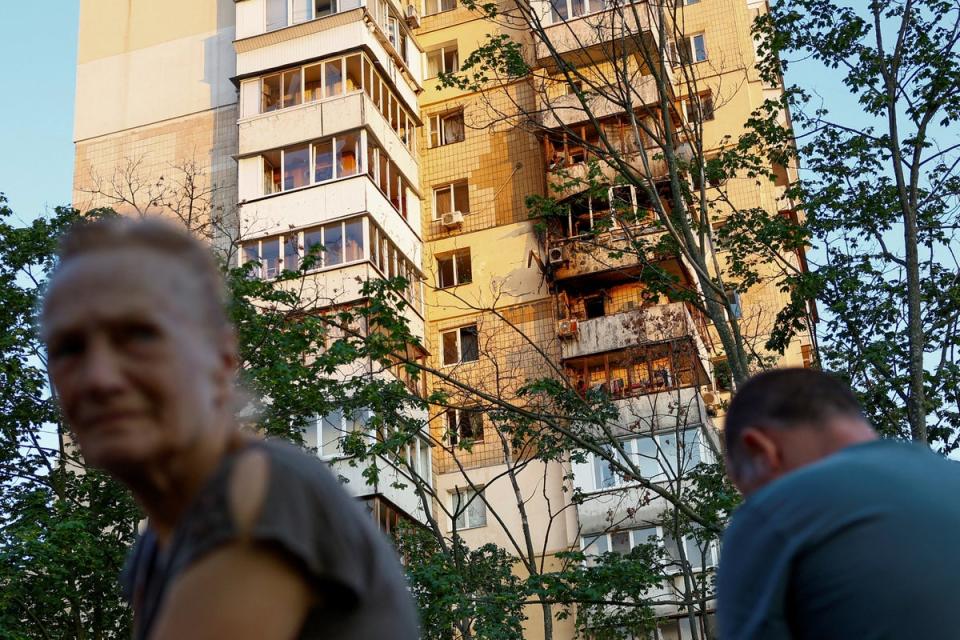Zelensky says Russia fired 800 glide bombs in a week as dozens injured in aerial attacks
- Oops!Something went wrong.Please try again later.
Ukraine’s president Volodymyr Zelensky has claimed that Russia fired more than 800 glide bombs at Ukraine in just the last week, as Moscow continues to use the modified Soviet-era explosives to kill both soldiers and civilians.
The bombs, which have been retrofitted with precision guidance systems and can be launched from aircraft flying out of range of Ukrainian air defences, have proved pivotal for Moscow in its effort to regain the initiative on the front line in recent months.
The bombs can weigh more than a tonne, and are capable of reducing entire multistorey buildings to rubble.
Residents of Kharkiv, one of the most frequently targeted civilian-populated areas in Ukraine, described the use of the bombs as a type of psychological torture, as even bomb shelters fail to protect against explosives that create such deep craters.
“This week alone, Russia has used more than 800 guided aerial bombs against Ukraine,” Mr Zelensky wrote on X, formerly Twitter. “Against our cities and communities, against our people, against everything that makes life normal.
“Ukraine needs the necessary means to destroy the carriers of these bombs, including Russian combat aircraft, wherever they are. This step is essential.
“Clear decisions are needed to help protect our people. Long-range strikes and modern air defence are the foundation for stopping the daily Russian terror. I thank all our partners who understand this.”
Ukrainians say the most effective means – and in most circumstances, the only means – of stopping this aerial threat is to deploy US-made F-16 fighter jets. But Kyiv’s partners have only recently overcome their hesitation in sending these aircraft to Ukraine, having previously considered such weapons too offensive in nature. The first batch of around 80 that have been pledged are due to arrive later this year.
But the bomb’s retrofitted navigation means Russian fighter jets can launch the bombs from well out of range of Ukrainian air defences, which are in short supply anyway, while longer-range missiles supplied by Kyiv’s partners cannot engage airborne, mobile targets.
Kyiv maintains that the provision of F-16s will allow them to take on Russian fighter jets while they are in the air, destroying the bombs before they have been released.
Dozens of Ukrainians, including an eight-month-old infant, have been injured in Russian aerial strikes over the past 24 hours.

On Sunday, one person was killed and nine others, including the infant, were injured in a strike on a post office in Ukraine’s second-largest city, Kharkiv.
The head of Kharkiv’s regional administration, Oleg Synegubov, said the strike had damaged a post office in the city, killing one of the employees.
Through Sunday night and into Monday morning, strikes in the capital, Kyiv, and further southeast in Dnipro, injured at least 13 people, including two teenagers.
Meanwhile, the governor of Russia’s Belgorod region claimed in a statement that a civilian had been killed during the shelling of an agricultural facility.
Moscow says Belgorod, which borders Ukraine’s Kharkiv region, has come under regular attack from Ukrainian forces.
Russia’s defence ministry also claimed that its forces had taken control of two villages in eastern Ukraine. The ministry said in a statement that the Russian army was now in control of the settlement of Stepova Novoselivka in the Kharkiv region, and of Novopokrovske in Donetsk.
However, Ukrainian war tracker DeepState, known to have close ties to the military, reported that both towns were still under Ukrainian control.

